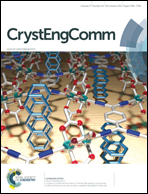Synthesis and thermometric properties of shuttle-like Er3+/Yb3+ co-doped NaLa(MoO4)2 microstructures
Abstract
Yb3+/Er3+ co-doped NaLa(MoO4)2 up-conversion (UC) monodisperse shuttle-like microcrystals were prepared by a hydrothermal method without any organic solvents or surfactants. The phase purity, structure and morphology of the samples were characterized by X-ray diffraction (XRD), field emission scanning electron microscopy (FE-SEM) and transmission electron microscopy (TEM). The effects of the initial reaction solution pH values and reaction time on the morphologies of the final products were investigated. The temperature-dependent UC luminescence and temperature sensing properties of the samples were discussed according to the fluorescence intensity ratio (FIR) of green emissions from 2H11/2/4S3/2 → 4I15/2 transitions of Er3+ at 530 and 550 nm in the range of 300–510 K under excitation of a 980 nm laser. After sintering at 600 °C for 1 h, the UC intensity of the sample increased about 1070 times that of the sample without calcination, and the maximum sensitivity of the samples with and without calcinations was approximately 0.0131 K−1 at 510 K and 0.0135 K−1 at 450 K, respectively. The results indicate that the sensitivity is hardly dependent on the UC luminescence intensities of the samples, and the present shuttle-like NaLa(MoO4)2 monodispersed microcrystals exhibited excellent temperature sensing properties.


 Please wait while we load your content...
Please wait while we load your content...